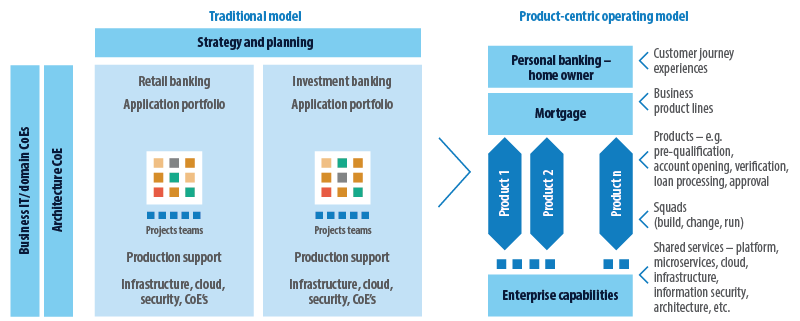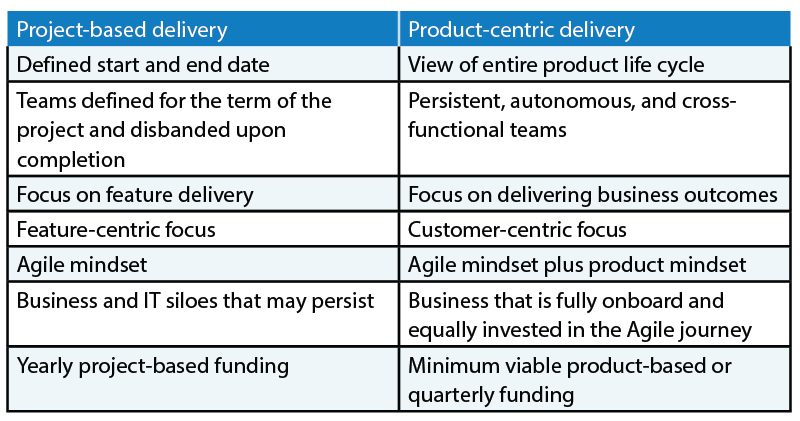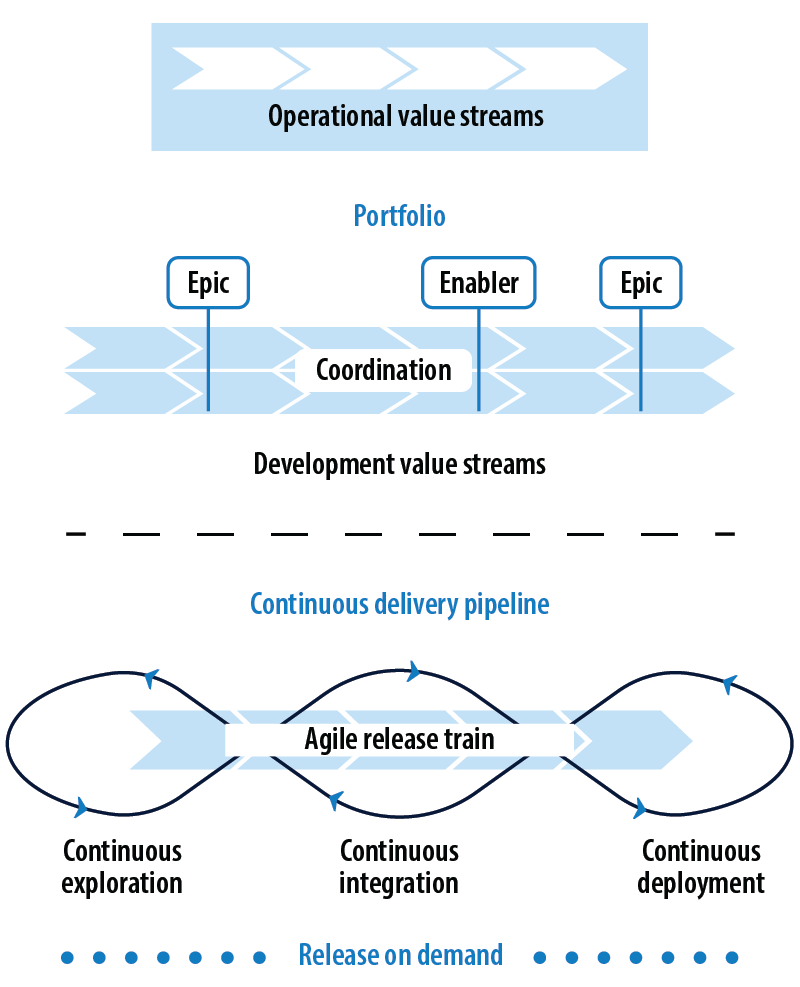- Product-centric delivery is less about products and more about the value that is delivered.
- In product-centric delivery, capabilities and services are delivered by a line of business or multiple lines of business together, which are often grouped around an end-to-end customer journey.
- Business outcomes are measured by objectives and key results (OKRs), which help firms track value flow, create alignment, and encourage engagement around measurable goals.
- Many enterprises are using product managers to catalyze their move towards a product-centric delivery model.
- This approach enables customer-centricity across the value chain and helps build products that are innovative and effective in the chosen market. Firms adopting product-centric delivery achieve business value faster and can course correct when necessary, further amplifying innovation.
- Depending on the business strategy, the approach might focus on client experience, customer journeys, or value streams.
Younger, digital native businesses, often enter an industry with many advantages. This could include a flatter organizational structure, more agile ways of working, and the ability to drive fast paced innovation cycles. But their most powerful weapon is often their mindset — a strong focus on customer value at every touchpoint in their journey.
This approach is known as product-centric delivery. But its less about products and more about the value that is delivered. A product is a named collection of business capabilities valuable to a defined customer segment. A product may be just software and data. Alternatively, it may comprise any combination of software, hardware, facilities and services, as required to deliver the entire product experience. A product may be a repeatable service (for example, a subscription service); or it may be a platform (one-sided or multi-sided).1
Capabilities and services are delivered by a line of business or multiple lines of business together, which are often grouped around an end-to-end customer journey. In doing so, business lines within the firm collaborate to create products of increasingly greater value to their customers. Business outcomes are measured by objectives and key results (OKRs), which help firms track value flow, create alignment, and encourage engagement around measurable goals.
Companies that adopt this innovative — and increasingly necessary — approach organize their IT delivery around specific customer journeys and associated value streams rather than traditional functions that support the production and operations of the business (see Figure 1). This can lead to the faster deployment of new technologies that can increase customer experience, retention and sales.
Figure 1. In the product-centric operating model, IT delivery is aligned to customer journeys

Source: Infosys
For example, Tesla’s “dynamic personalization” approach treats each car as an individual experience. At the click of a button, software understands who is driving and changes everything, from suspension settings to braking, lights, and radio presets. With data-driven design, each car picks up movements from numerous sensors, which it then connects to create a full picture of the driving experience. As software improves over time, the entire driving experience can also evolve and improve. Going further, Tesla, the fastest-growing company in the world, will soon use interior-facing cameras and the fully upgradable dashboard to align driver mood with best driving routes, treating the car as a customer journey in and of itself.2
Oakland-based Sungevity, a residential solar panel provider, also does product-centricity extremely well. The business manages the end-to-end process of sales and custom installation, working with an ecosystem of providers that supply, finance, install, and service the panels. With good data management of the solar potential of each home or business, Sungevity can provide tailored calculations for each customer on how much it can save on energy costs over a year. Once customers are onboarded, they receive regular reports on their panel’s energy generation and resulting savings, along with information on how to conserve energy based on household characteristics. In this way, the product becomes a seamless digital journey. With much of the hard work simplified — and, where possible, automated —many customers remain in a monogamous and open-ended engagement with the firm.3
Executives at traditional companies have taken note of this approach. Our research found that 74 percent of C-suite and IT executives, across US and Europe, invest their money in product management, underlining it as a key business priority.4 Many enterprises are using product managers to catalyze their move towards a product-centric delivery model. To reach that goal, however, firms need to rethink both what they do and how they do it. A software-defined operating model allows businesses to cater to shifting customer behaviors and create a firm foundation for innovation. An agile culture rewards innovation and sees failure as a learning process. The central tenet of experimentation permits companies to deliver solutions quickly in rapid feedback loops. And teams can use DevOps to deliver high value customer solutions at speed, bringing together cross-organizational capabilities.
74% of the C-suite across business and technology are investing in product management
The problem with project-based delivery
These patterns of Agile adoption are already common in large-enterprise IT departments, but the business side has usually lagged. Often, operating units have not integrated product centric Agile behaviors at all. They still have fragmented value chains and siloes, which makes it difficult to realize the intended business outcome and end-user experience. In our Agile Radar research, we found that incumbent business owners named cross-functional collaboration as a top concern — one that reduced their ability to innovate quickly.5
However, the main problem is that most struggle to move away from project-based approaches. Legacy thinking and slow, analog processes are the norm in many enterprises. In this model, project managers are tasked with completing delivery on time and on budget. Initiatives are divided into multiple projects that are delivered independently. This often leads to a limited view of the problem the solution is trying to solve. Due to misaligned objectives, various project teams are unable to pivot quickly if customers don’t like the product or if growth stalls and an entirely new product strategy is necessary.
Figure 2. Key differences between project-based and product-centric value delivery

Source: Infosys
Benefits of product-centric value delivery
Product-centric delivery is a mindset change and requires strategic thinking. But those organizations that get it right are poised for success. This approach enables customer-centricity across the value chain and helps build products that are innovative and effective in the chosen market. As they evolve, these firms are made up of Agile teams that are aligned to an overarching purpose and vision, with each unit or pod delivering significant business value. They also achieve this business value faster and can course correct when necessary, further amplifying innovation. We explore these benefits further below.
Stay in tune with the wider market
Product-based, data-driven firms are able to more quickly take advantage of business opportunities. As the pandemic raged across the U.S. in 2020, fitness equipment company Peloton was able to seize the opportunity presented by the circumstances. Data from its machines enabled the firm to better understand how to price its signature stationary bike and fitness classes effectively during the lockdowns. A rebranding for Christmas 2020 — chic gym ware for the upper-middle class — was guided by knowledge of the complete customer journey, from first contact to app subscriptions. Peloton unlocked the motivations that might prove a barrier to entry (expensive prices) and those that engender loyalty (large collection of curated fitness classes). Even as gyms reopened, the company’s knowledge of what customers want from fitness equipment enabled the firm to deliver 128% revenue growth with a churn rate below .75% in the 2021 fiscal year.6
Compose an enterprise vision
Lean and orchestrated customer journeys create a common purpose and a shared vision across the company. Agile Radar research7 found this shared vision increases business value when combined with mature Agile behaviors, such as upskilling and self-organized teams. In this way, businesses shift their focus from releasing more features to creating more value, which helps ensure that products are relevant to users.
Visionary Agile organizations are those that are “creating and managing their value stream networks and product portfolios in order to leapfrog their competition in the age of software.” — Mik Kersten, author of “Project to Product: How Value Stream Networks Will Transform IT and Business”
Foster a culture of innovation and experimentation
Product-centric delivery is also characterized by a culture of innovation and experimentation. At Airbnb, the engineers, data scientists, and product managers experiment with new ideas every week.8 For instance, the team experimented with replacing static headlines for the Become a Host landing page with dynamic natural language forms. These forms, which included the type of place, number of guests, and location of property, then provided the total dollar amount that each user could expect from selling on the site.9 Though the test variation was eventually rejected, experiments such as these allow the company to understand what customers really want from their experiences. This enables product owners and business sponsors to define their strategy, which unlocks more funding from the top reaches of the organization. Divisions that have this culture are able to satisfy customers with ever-better products.
IT as a stronger force in business
Product centric delivery also encourages IT and business integration, with no hand off between the two. Here, technology and business are considered to be both integral to the product strategy, equally invested in the success of the product. Teams collaborate to build a product in a persistent construct, with a shared objective linked to organizational vision and impact on bottom-line, top-line and market growth.
Create new business models
This approach can also lead to the creation of new business models and revenue sources. Spanish telecom Telefonica uses a product-centric, lean startup approach to Agile that allowed the company to monetize customer data. The telecom used mobile device data to help the Spanish government understand which tourist sites are most popular and to create effective data maps for EU smart cities efforts.10
Pave the way for a platform ecosystem to flourish
Product-centric delivery also paves the way for a flourishing platform ecosystem. A platform helps an organization to create new services for the market and increases efficiencies and scale in the organization. Amazon Web Services is an example of an external platform that acts as the primary profit driver of the business, accounting for more than 13% of total revenue as of 2021.11 The platform offers partners three main services: EC2, Amazon’s virtual machine service, Glacier, a low-cost cloud storage service, and S3, Amazon’s storage system. In another example, an Asian shipping giant used a product-centric operating model to extend its internal data and analytics capabilities to its clients. Application programming interfaces offered as internal capabilities to teams for building efficiencies and scale were offered as a service to customers with analytics on shipping routes, container locations, and cargo tracking.
Further development will allow additional knowledge sharing, collaboration among partners and customers, and data artifacts available in a self-service portal.
Operate like a digital startup
Product-centric delivery gives companies the ability to operate like a digital startup, with more innovation, quicker product feedback loops, a focus on experimentation and an organizational structure with less administration and hierarchy. In our Agile Radar research, we found that firms that have more of a startup culture in their DNA achieved better business and IT outcomes. We called these firms “sprinters” since they started Agile more recently but have adopted these practices at scale.12
These companies — as diverse as Peloton, General Electric, and Ocado — are customer-centric and innovative. They also invest in continuous learning for their workforces. Sprinters focus on creating a sustainable ecosystem to support Agile ways of working. They use data, analytics, and artificial intelligence (AI) at scale and focus on value streams more than other firms do.
In one example, a large transportation and logistics player operated like a technology-driven product startup, able to rapidly innovate to build a digital freight marketplace platform ecosystem. This platform acted as a foundation for product development — across retail customer, carrier, and freight operator personas. Product features evolved out of well-organized hackathons and product teams monitored its usage to suggest improvements.
Achieve stronger growth
Product thinking keeps employees in tune with both market and client demands. Agile and DevOps ways of working ensures faster releases and feedback loops to further refine the product for the market. Every member of the value chain has accountability, enabling firms to meet business goals on the product roadmap. All of this increases the chance of stronger growth and ensures that employees are engaged, productive, and in tune with customer behavior. Agile Radar 2021 found that product-centric value delivery, along with a mandate to upskill employees and set up remote working facilities, can increase the chance of growth compared to peers by 63%.13 Firms that focus on delivering high-value, customer-pleasing products also tend to have a more coherent business strategy and leaders who inspire employees to do their best work.
Current product-centric delivery approaches
There are various ways to instill product-centric delivery in an organization. Depending on the business strategy, the approach might focus on client experience, customer journeys, or value streams. The customer journey and value stream aligned product models are more often adopted by large enterprises. Focusing on customer journeys ensures that insights can be captured across all customer touchpoints. And the value stream approach is a cohesive set of activities that optimizes value across the entire product life cycle.
Focusing on customer journeys ensures that insights can be captured across all customer touchpoints
Scaled Agile Frameworks (SAFe) also provides a way to visualize and identify value streams while addressing product-centric delivery (see Figure 3). Here, firms must identify how value flows through the organization at the operational level. Then product value streams support operations from end to end. This helps visualize the flow of value through multiple systems and forms the basis for team dynamics. Going further, fully autonomous, persistent, and self-organizing teams are grouped into Agile release trains and collaborate extensively to deliver the desired business outcomes.14
Figure 3. SAFe’s value stream approach to value delivery

Source: SAFe
The most effective strategy depends on the firm’s operating model and organizational structure. Many innovative firms try different product-centric approaches in a test-and-learn mode. Often, they start with a pilot project and choose one area of the business that would benefit from greater consumer engagement and high growth potential. The product introduced in this way acts as a catalyst to make incremental changes across people, processes, and technology. Lessons are evangelized across the organization. More refined products can then be introduced in tiers, with value assessed at regular milestones. One particular hotbed for this sort of innovation is the research and development function, which already has experimentation as its mission.
In one example, a German chemical company introduced product-centricity into its research and development department. This approach led to rapid product iterations, early customer involvement, and better cross functional collaboration. Subsequently, the department’s productivity increased by 20%, since it could now pivot early in the development process or discontinue initiatives altogether. Minimum viable product-based testing with an industrial detergent ultimately led the firm to shelve research that otherwise would have resulted in failure.15
Further, product-centric delivery can become a continuous innovation process with product teams invested in growth beyond launch of the capability or service in the market. At Peloton, an innovation flywheel effect ensures that new data captured on virtual fitness studios continues to impact product development. Teams persist to develop an ongoing contextual understanding of customers and other end users, which in turn leads to better design research processes. This human centered approach then spurs more innovation, driving deeper, richer end-user engagement and business outcomes.
How to make a product-centric approach successful
Regardless of organization size, technology, and team abilities, there are certain elements that all firms need in order to make product-centric delivery work. We have found that incumbents are the most successful when they focus on journeys that have high impact and create dedicated, cross-functional teams to support them. Executive mandates for product-centricity should focus on the following initiatives.
- Business strategy, market, and user needs drive the product definition. By classifying products before any other work is carried out, firms can determine whether a focus on value chains, customer journeys, or value streams best achieves this strategy. Product teams are aligned to orchestrate the flow of value, with a product strategy, roadmap and vision statement put in place to target key user personas.
- A product team can be composed of three topologies: feature teams, platform teams, and enabler teams. Roles and responsibilities for each team topology are mapped out before re-organizing the teams around value streams. It is important here that there is high levels of business and IT alignment so that team roles are optimized with minimal redundancy.
- A lean governance model should be used with MVP-based funding, joint ownership between an enterprise and its partners, Agile release trains, and product OKRs. OKRs connect build-measure-learn components of the product life cycle. These objectives define various product key performance indicators (KPIs) and metrics and also ensure alignment and joint monitoring by business and technology leaders. The OKR framework evolves over time, and partners take greater ownership in product KPIs and business outcomes.
- A product mindset ensures teams are in tune with both market and customer demands. Design thinking workshops are used to give product teams a greater insight into customer personas and their needs. Enablement programs can be used to make work between product owners and engineering personnel more productive and fulfilling.
- A product organization helps align and integrate IT and business teams, defines the product roadmap, and gets executive buy-in. Product owners work with senior leaders to define and achieve high-level business outcomes, laying the groundwork for further innovation. A community of practice (CoP) can be used for knowledge sharing and upskilling between team members with similar roles and attributes.
- To drive product-centric delivery, a focus on Agile-DevOps adoption is often necessary. A good partner helps here, and has the capabilities to ideate, develop, test, release and operate the solution with the enterprise. Partners offer joint ownership for business outcomes and provide assurance and accountability throughout the product lifecycle. Business outcomes are themselves well defined in advance through relevant product KPIs, with closer partnership offering the ability to inspect and adapt these KPIs after relevant sprint cycles. The partner should also help create small, autonomous, and persistent teams of experts with domain knowledge across business and technology. With a one-team culture, these product-centric delivery units increase customer stickiness and lead to joint innovation. Another big plus of finding the right partner is the technology angle; successful partners have integrated tool chains and expertise in AI, Cloud and DevOps, which are the need of the hour and essential to digital transformation and innovation.
Unique products that delight customers
Digital natives and visionary firms have already established how a product-centric operating model can increase business agility and weave innovation throughout their operating units. It is also apparent that product-based delivery improves other business outcomes. Firms that fully utilize their product management and experience design capabilities increased their market share, lowered costs, and made employees happier, according to our Agile Radar research. Executives also said that onboarding highly skilled, customer-centric product managers was one of the top investments for 2021.16
Onboarding customer-centric product managers is a top investment for 2021, according to Agile Radar research
Visionary firms will use these approaches to reimagine internal customer journeys and set up persistent, self-organized product teams to bring these journeys to life. Through persona-based insights — powered by AI and data analytics — the most advanced firms will provide customers with products and services they didn’t even know they wanted.
A sound Agile strategy requires executives and managers to look more closely at the cultural makeup of their teams, focus on value created rather than project delivery, and provide leadership that moves the right levers — at the right time — to sprint ahead of the competition.
References
- Gartner glossary: product (digital business), Gartner.
- 3 ways Tesla creates a personalized customer experience, Blake Morgan, May 10, 2021, Forbes.
- Competing on customer journeys, David C. Edelman and Marc Singer, November 2015, Harvard Business Review.
- Agile Radar 2021, Infosys.
- Agile Radar 2021.
- Peloton quarterly sales top $1 billion, but shares fall as cycle maker steps up further supply chain investments, Lauren Thomas, Feb. 4, 2021, CNBC.
- Agile Radar 2021.
- The designer who changed Airbnb’s strategy, Emily Fields Joffrion, July 9, 2018, Forbes.
- Airbnb a/b tests and rejects a natural language form, Apr. 20, 2021, GoodUi.org.
- Luca and carto to work together bringing location to the next frontier of big data, Eva Cabanach, Nov. 2, 2016, Cart.
- Agile Radar 2021.
- Agile Radar 2021.
- Agility, acceleration, and innovation in network engineering, Anunay Kumar and Arul Rosaline Pradipa, March 2021, Infosys.
- Why science-driven companies should use Agile, Alessandro Di Fiore, Kendra West, and Andrea Segnalini, Nov. 4, 2019, Harvard Business Review.
- The complete guide on continuous innovation, Danni White, Apr. 24, 2020, Tech Funnel.
- Product > Project: Accelerating Agile, Jeff Kavanaugh, Aug. 10, 2021, LinkedIn.





